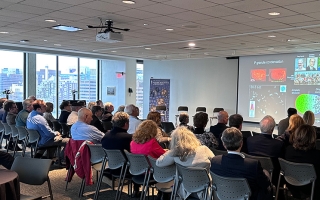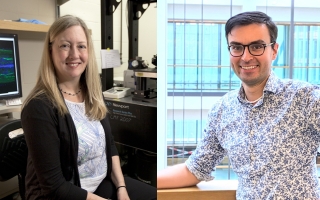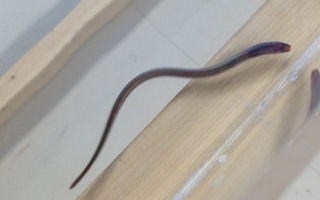Full Name
Jennifer Morgan
Title
Senior Scientist and Director, Bell Center

- Email:
- Phone:
- Fax:
- CV:
File
- ORCID ID:
0000-0001-9915-6360
B.S. with Honors, Biology, The University of North Carolina at Chapel Hill, 1995
The laboratory of Dr. Jennifer Morgan studies the cellular and molecular mechanisms by which neurons communicate with each other at synapses, a process called synaptic transmission. We study mechanisms of normal synaptic transmission, as well as how neurotransmission is impacted by spinal cord injury and disease. One ongoing project involves identifying how synapses are deleteriously affected by Parkinson's disease, and we are currently developing strategies to slow or reverse disease-associated synaptic dysfunction. Another project is focused on understanding how neurotransmission can be restored after spinal cord injury by regenerative processes, such as axon and synapse regrowth, or other forms of neural plasticity. Ultimately, we want to understand how these regenerative processes contribute to restoring normal behaviors after injury and how to improve functional outcomes.
For these projects, we use sea lampreys (Petromyzon marinus) as our model organism. Lampreys are cyclostomes, which are the most basal extant group of vertebrates. Lampreys possess a subset of very large neurons that can be identified across animals, the giant reticulospinal (RS) neurons, which provides several advantages for our studies. First, as the name indicates, these RS neurons are giant! They have especially large axons (20-80 microns) and synapses (1-2 microns), which are easily an order of magnitude larger than in most vertebrate models. Second, these giant neurons are experimentally tractable and amenable to molecular manipulations both in the normal and regenerating state. To approach our questions, we utilize a variety of technical approaches including, candidate gene and transcriptome analyses, molecular perturbations, biochemistry, fluorescence imaging, histology, electron microscopy, electrophysiology, and behavior.
Wallace JN, Crockford ZC, Román-Vendrell C, Brady EB, Hoffman C, Vargas KJ, Potcoava M, Wegman ME, Alford ST, Milovanovic D, Morgan JR (2024) Excess phosphoserine-129 a-synuclein induces synaptic vesicle trafficking and declustering defects at a vertebrate synapse. Molecular Biology of the Cell. 35(1):ar10. doi: 10.1091/mbc.E23-07-0269. (* Cover illustration)
Casiano Rivera CV, Wallace JN, Fisher GE, Morgan JR (2024) Acute introduction of phosphoserine-129 a-synuclein induces severe swelling of mitochondria at lamprey synapses. microPublication Biology. 10.17912/micropub.biology.001206. PMCID: PMC11157340. doi: 10.17912/micropub.biology.001206.
Maxson Jones K, Morgan JR (2023) Lampreys and spinal cord regeneration: “a very special claim on the interest of zoologists,” 1830s-present. Frontiers in Cell and Developmental Biology. 11:1113961. doi: 10.3389/fcell.2023.1113961. PMID: 37228651.
Hamlet C, Fauci L, Morgan JR, Tytell ED (2023) Proprioceptive feedback amplification restores effective locomotion in a neuromechanical model of lampreys with spinal injuries. Proceedings of the National Academy of Sciences. 120(11):e2213302120. doi: 10.1073/pnas.2213302120. PMID: 36897980.
Brady EB, McQuillan M, Medeiros AT, Bubacco L, Sousa R, Lafer EM, Morgan JR (2023). Hsc70 rescues the synaptic vesicle trafficking defects caused by α-synuclein dimers. microPublication Biology. 10.17912/micropub.biology.000737. PMID: 3698331. doi: 10.17912/micropub.biology.000737
Pattanayak R, Underwood R, Crowley MR, Crossman DK, Morgan JR, Yacoubian TA (2022) Deletion in chromosome 6 spanning alpha-synuclein and multimerin1 loci in the Rab27a/b double knockout mouse. Scientific Reports 12:9837 doi: 10.1038/s41598-022-13557-8.
Katz HR, Arcese AA, Bloom O, Morgan JR (2022) Activating transcription factor 3 (ATF3) is a highly-conserved pro-regenerative transcription factor in the vertebrate nervous system. Frontiers in Cell and Developmental Biology.10:824036. doi: 10.3389/fcell.2022.824036.
Fouke KE, Wegman ME, Weber SA, Brady EB, Román-Vendrell C, Morgan JR (2021) Synuclein regulates synaptic vesicle clustering and docking at a vertebrate synapse. Frontiers in Cell and Developmental Biology. 9:774650. doi: 10.3389/fcell.2021.774650.
Fies J, Gemmell BJ, Fogerson SM, Morgan JR, Tytell E, Colin SP (2021) Swimming kinematics and performance of spinal transected lampreys with different levels of axon regeneration. Journal of Experimental Biology. jeb.242639. doi: 10.1242/jeb.242639.
Haspel G, Severi KE, Fauci LJ, Cohen N, Tytell ED, Morgan JR (2021) Resilience of neural networks for locomotion. Journal of Physiology. doi: 10.1113/JP279214.
Román-Vendrell C, Medeiros AT, Sanderson JB, Jiang H, Bartels T, Morgan JR (2021) Effects of excess brain-derived human a-synuclein on synaptic vesicle trafficking. Frontiers in Neuroscience. 15:639414 doi: 10.3389/fnins.2021.639414.


